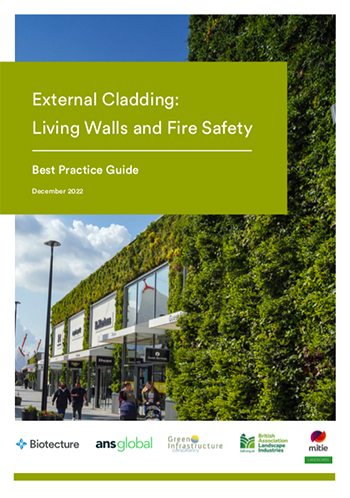Living Walls and Fire Safety. Best Practice Guide Dec 2022
The Living Wall industry has launched a best practice guide for designers and specifiers to provide clarity on the latest National Building Regulations.
In response to the Government's introduction of a new framework to further strengthen and clarify building regulations and fire risk guidance as part of wider reforms to building safety, the Living Wall industry's two largest installers, Biotecture and ANS Global, have summarised the changes to the Government's Approved Document B and included industry recommendations on the specifications and materials to be used, including the type of plants.
National legislation now clearly determines the building types where external cladding can be used, which includes Living Wall installations. This means that residential dwellings above 11m high where people sleep are no longer compliant, but all other building types are.
Ways to minimise risk of fire, outlined in the guidance, include selecting plants with low calorific value and propensity for heat and enacting robust irrigation procedures, preventing plants from drying out.
The guide also explains the third-party Engineering Assessment reports and testing procedures to ensure compliance, such as fire certification test BS EN 13501-1, and effective maintenance procedures to follow.
The summary of Best Practice Guidance states that a Living Wall as external cladding should:
- Comply with the relevant requirements of Approved Document B; June 2022 update in accordance with independent third-party testing of the whole system including plants through whole system Engineering Assessments
- Only include materials and plants that have been incorporated in destructive third-party Engineering Assessments or that are demonstrably similar in nature in reaction to fire to those that have been part of full system Engineering Assessment tests as stated in the guidance
- Include an irrigation system that has been designed, installed, and operated in accordance with the Best Practice Guidance
- Always have a proactive maintenance contract in place with a proven supplier who can demonstrate experience of ensuring continued compliance for Fire Safety.
Richard Sabin, Managing Director, Biotecture said: “This industry Best Practice Guidance is designed to clarify and explain the latest regulatory framework for Living Wall installations and offer recommendations to allow designers and specifiers to condition with confidence. We recommend that the design and planning industry follow this guidance to minimise fire risk and ensure Living Walls remain compliant with national regulations, as we drive forward urban greening and maximise the benefits of green infrastructure in our cities and towns.”
Richard Silcock, Managing Director, ANS Global said: “Living Walls clean the air around us, drive biodiversity and make us happier. As an industry we hope this guidance will provide helpful direction for those who plan our cities and enable us to tap into the potential of urban spaces across the country, in a responsible and compliant way. Together we can plan for a greener, healthier future.”
Download the Living Wall Best Practice Guide in full
This article appears on the CIAT News and Blog site as "Best practice guidance launched by Living Wall industry" dated January 4, 2022.
--CIAT
[edit] Related articles on Designing Buildings
- Algae.
- Biotecture celebrates 15 year anniversary.
- Biotecture living hoardings installed at Stonecutter Court, London.
- Biotecture living hoarding front to Belgravia development.
- CityTrees.
- Dynamic façade.
- Façade.
- Green roof.
- Hydroponics.
- Kinetic facade.
- Landscape design.
- Rain garden.
- Sustainability.
- Urban treescape.
- Vertical Forest.
Quick links
[edit] Legislation and standards
Fire Safety (England) Regulations 2022
Regulatory Reform (Fire Safety) Order 2005
Secondary legislation linked to the Building Safety Act
Building safety in Northern Ireland
[edit] Dutyholders and competencies
BSI Built Environment Competence Standards
Competence standards (PAS 8671, 8672, 8673)
Industry Competence Steering Group
[edit] Regulators
National Regulator of Construction Products
[edit] Fire safety
Independent Grenfell Tower Inquiry
[edit] Other pages
Building Safety Wiki is brought to you courtesy of:







Comments
[edit] To make a comment about this article, click 'Add a comment' above. Separate your comments from any existing comments by inserting a horizontal line.